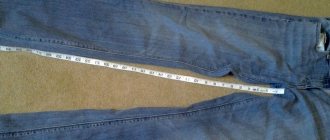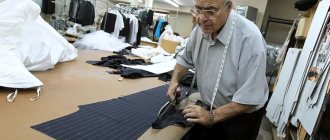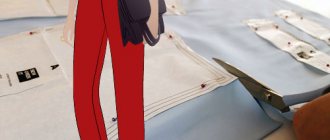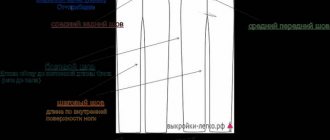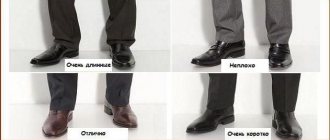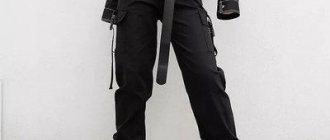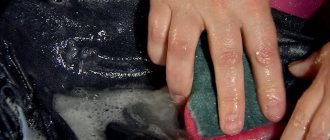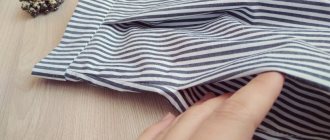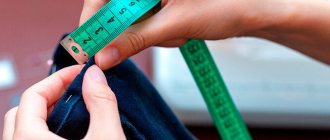Home → Patterns → Defects in the fit of trousers (part 2)
Defects in the fit of the trousers at the back spoil the impression of the suit, giving it a sloppy look.
In the previous article, we told you about fit defects and their correction if they occur in the front of trousers. Today we will talk about defects in the fit of trousers in the back.
Types of defects in the fit of trousers at the back and ways to correct them
Basically, the fit of the trousers depends on the correct inclination and length of the seat seam. You can see this pattern in the figure below.
Dependence of the length and inclination of the middle seam (seat) on the shape of the buttocks
The more convex the shape of the buttocks, the greater the slope and the longer the seat seam. The inclination itself can be determined based on the measurement of the depth of the back deflection. And it can even be measured. Details in the article “Darts at the waist. How to measure?
Measuring the back arch depth
Excessive weakness under the buttocks
The defect occurs due to the excess length of the seat seam at the top and in the step area.
The first way to eliminate this defect is to lower the waistline by the required amount and shorten the step length of the rear half.
Flat buttocks
Another option to fix this defect
- set aside 10 cm from the step line down and up,
- from the middle seam line to the right approximately 12.5-15 cm,
- cut the pattern of the back half along the marked lines and move the cut part to the right to the required distance, as shown in the photo. Thus, we will reduce the width of the step by moving part of the cut out pattern to the left, as shown in the photo.
Don't forget to lower the waistline and create a smooth line on the new back middle seam.
LiveInternetLiveInternet
Quote from koko_shik
Read in full In your quotation book or community!
Sewing - Technologies and sewing tips - Correcting defects in the fit of trousers
koko_shik
Any defects in the fit of trousers usually arise due to certain characteristics of the figure. Source
We systematized the features of the figure and developed recommendations for correcting defects in trousers.
Full hips
With full hips, horizontal creases or folds may form.
How to fix? To correct such a defect, it is necessary to increase the volume of the front and back halves of the trousers in the hip area, as shown in the figure:
Full hips with riding breeches
The trousers also develop horizontal folds and creases, and the trousers appear very narrow in the hip area.
How to fix? If there is a pronounced “breeches” area, it is necessary to adjust the pattern as shown in Fig. 2. To do this, on the front halves of the trousers, draw two parallel segments 10-15 cm long above the step line 2-3 cm and 10 cm below the step line. Connect the ends of the segments. Cut the pattern along the marked lines, move the cut out part to the left by 1-3 cm (depending on the lack of volume), and draw a new side line. Adjust the back half of the trousers in the same way.
Full thighs on the inner thighs
The trousers develop slanting folds at the top of the legs in the area of the inner surface, creating the feeling that the fabric of the trousers is pulled and folded.
How to fix? Cut the pattern of the front half of the trousers below the step line and move the bottom of the pattern to the right by 1-2 cm. Draw a new side line and step line. Adjust the back half of the trousers in the same way.
Thin legs
The pants look big and baggy and there is excess fabric in the hip area.
How to fix? To correct this deficiency, it is necessary to determine the total excess volume that needs to be removed and distribute it between the parts of the front and back halves of the trousers. To do this, measure the circumference of your leg at the top and compare it with the value on the pattern. Determine the difference between the measured value (with the desired increase in fit) and the actual pattern value. Set aside ¼ of the resulting value along the side and inseams of the front and back halves of the trousers, thus reducing the width of the trousers in the leg girth area at the top.
Flat buttocks
With this defect, excess, weak tissue is formed on the buttocks and under them.
How to fix? To eliminate the defect, you need to lower the waistline by the required amount and shorten the step length of the rear half.
The second option for correcting the defect: on the back half of the trousers, draw two parallel segments 10-15 cm long above the step line 2-3 cm and 10 cm below the step line. Connect the ends of the segments. Cut the pattern along the marked lines, move the cut out part to the left by 1-3 cm and draw a new line for the middle seam of the back half and the crotch seam.
Flat buttocks can also cause folds to form under the buttocks. To correct such a defect in ready-made trousers, pin the excess fabric in the form of a transverse fold on one of the legs from the middle seam to the side seam (Fig. 7). Eliminate the crease. Open the middle seam from the crotch to the waistband. Place the pinned and unpinned pant legs right sides together. On the side of the chipped part, fix the trouser legs in the position that was obtained due to the reduction of the rounded neckline.
Shift the excess length along the middle seam of the unpinned trouser leg upwards. Transfer the new seam line to the protruding half of the trousers lying below. Remove the pins. Sew the middle seam along the modified back seam line, trimming off any excess seam allowance. Tuck the excess length of the middle seam into the waistband.
Large protruding buttocks
With this defect, creases and folds form on the back middle seam of the trousers, most often in its lower part. The pants cut into the body.
How to fix? To do this, on the back half of the trousers from the step line, set aside 10-11 cm up and down, and draw 2 parallel sections 12-15 cm long. Connect the ends of the sections. Cut the pattern along the marked lines, move the cut out part to the left by 1-3 cm and draw a new line for the middle seam of the back half of the trousers and the step line.
Fold at the waist
On the back halves of the trousers, a horizontal fold is formed at the belt stitching line.
How to fix? This means that the length of the back middle seam of the trousers is too long and it is necessary to shorten the middle seam of the trousers by the amount of the resulting crease. Extend the waist dart to its full length.
Protruding belly
If there is a protruding belly, a defect may form on the trousers in the form of folds around the abdomen, as well as in the upper part of the legs.
How to fix? To correct this defect, additional length must be added to the length of the front middle seam of the trousers. Cut the pattern of the front half of the trousers horizontally at the level of the stomach and spread the pattern as shown in Fig. The amount of increase depends on the volume of the abdomen. Make the middle seam of the trousers and the side seam a smooth line.
SOURCE: Anastasia Korfiati Sewing School
Series of messages “Sew - Pants”:
Part 1 - Boho Pants. Patterns Part 2 - “Fast” trousers for the summer. MK ... Part 12 - Adjusting the trouser pattern when trying on Part 13 - Sewing trousers with pleats. Video MK by Tatiana Rogova Part 14 - Sewing - Technologies and tips for sewing - Correcting defects in the fit of trousers
Folds at the bottom of the seat seam
The defect occurs when the buttocks are convex and is formed due to insufficient length of the seat seam and sometimes the width and slope of the back half.
You can also fix it in two ways. If the problem is minor, simply increase the lower part of the back half of the trousers by the required amount, as shown in the photo.
Folds under the buttocks
The second option for correcting this defect is also to increase the step width. But in this case, we put 10 cm down and up from the step line, about 12.5-15 cm from the middle seam line to the right, cut the pattern of the back half along the intended lines and move the cut part to the left to the required distance, as shown in the photo. Thus, we expand the back half by an amount sufficient for the convexity of the buttocks, and also extend and increase the slope of the seat line
Folds under the buttocks
Waist pleat
If the length of the back middle seam of the trousers is longer than necessary, a soft horizontal fold may appear, which will be placed under the waistband. In this case, it is necessary to shorten the middle seam of the trousers by the amount of this fold.
Fold in the back waist area
For a better understanding of the formation of the middle seam of trousers, watch the video.
It’s good when adjustments to the features of the figure are applied on time, and even better when it is taken into account when constructing the pattern
A good fit of trousers depends on:
- from the cut,
- sewing technologies.
When creating trouser patterns and sewing using our method, you will not have such problems. In addition, there will be no need for special wet heat treatment (WHT), which everyone has heard about and is afraid of.
See details about the PANTS course
- Related Posts
- Set-in sleeves. Modeling
- Pants modeling
- Vintage skirts/dresses sun/half sun
- Skirts. How to sew different styles with your own hands
- Dream pants. Sew_cannot_buy
- A new approach to creating patterns for yourself and any family member
Discussion: 14 comments
- Irina Voroshilova:
August 23, 2021 at 10:27 pmLove, it’s difficult to give a definite answer. You need to see, or better yet, analyze the figure.
- Lyuba:
August 22, 2021 at 11:01 pm
And I have a flat stomach and a thin waist. I’ve been sewing myself for a long time, but I can’t perfectly shape the trousers in the front, below the fly, especially if the trousers are tight-fitting. But I settle the loose ones. There is always excess fabric. When I remove it, I get rays. What to do ?
- Irina Voroshilova:
June 25, 2021 at 02:05 pm
Slack in the side seam occurs when the trouser halves are sewn incorrectly. These are the basics of technology. This is covered in detail in the PANTS course.
- Novel:
June 24, 2021 at 11:00 pm
Hello! I see the point about the slack in the crotch area, but there is not enough lesson on the topic of slack in the outer side seam.
- Irina Voroshilova:
May 11, 2021 at 07:55 pm
Olga, you don’t need to touch the front half. Creases are formed due to the position of the back half of the trousers relative to the front. And with this action we correct the error.
- Olga:
May 11, 2021 at 00:12
Irina, thank you for your site!
Tell me, if the problem is according to point 4, then is it necessary to change the pattern of the front part of the trousers, in particular, the length of the crotch seam?
- Irina Voroshilova:
January 11, 2021 at 10:50 am
Rita, by and large, you need to take photographs in tight-fitting clothes or underwear in profile and full face and analyze your figure in order to identify all its features.
- Rita:
January 11, 2021 at 00:18
How about adding amendments to the “breeches” to the first drawing? After all, there are women who have convex buttocks and “breeches”! And that's a problem! It is very necessary to see the dependence of the lines of the drawing on the silhouette of the hip together with the convex buttocks. .
- Irina Voroshilova:
October 1, 2021 at 10:27 am
Lyudmila Stepanovna, what book are we talking about?
- Lyudmila Stepanovna Mazanova:
September 30, 2021 at 2:21 pm
Problem with points 3 and 4. In ready-made trousers, using seams is unlikely to correct this. You have to sew it yourself. Where can I purchase or download your book?
- Elena:
September 18, 2021 at 02:38 pm
Dear Irina Voroshilova, you are a goddess, where were you 20 years ago! I have problem #2 with all the ready-to-wear pants. I figured out how to fix this myself 25 years ago (they had never even heard of the Internet at that time). Considering the fact that I am self-taught in sewing (except for school lessons on home economics - zero knowledge), I looked for ways to eliminate product defects in various manuals. Everything that I have seen so far (including on the Internet) is the second method and it was described somehow intricately. In addition, it is more suitable for those who sew trousers from the moment the pattern is created and, knowing the features of the figure, make adjustments already at this stage. I always corrected finished trousers using the first method. And although I always thought it was too primitive, such an adjustment gave me an excellent effect. I only read from you that this method exists. Thank you.
- Elena:
July 20, 2021 at 08:56 pm
Thank you very much. Very useful article
- Tatiana:
July 18, 2021 at 01:23 pm
Thank you very much for the course, a very necessary topic
- Valentina:
July 15, 2021 at 08:54 pm
Thank you, the material is great as always. I bought your course on trousers, a very good course, the trousers fit perfectly, I learned how to make trousers and pockets easily and quickly.
Correct fit of jeans - what is it like?
Two important rules to follow when adding a pair of jeans to your wardrobe are to take into account the type, strengths and weaknesses of your figure and choose the size wisely. Without taking these parameters into account, jeans will not fit well, namely, they will bunch up at the knees, at the back, in the groin, sag, etc. Let's see what popular jeans models are suitable for owners of different body types:
- Tight or skinny. This model lengthens the legs and emphasizes the hips. Suitable for triangle, rectangle and hourglass body types.
- Semi-loose or classic. They hide extra pounds and do not draw attention to “problem” areas - a full tummy, waist, hips. This is a good choice for ladies with a triangle figure - regular and inverted, hourglass, circle. Women with a rectangle figure should not choose this model.
- Spacious or boyfriends. They hide leg imperfections, emphasize the waist, and disguise narrow hips. Bad choice for "triangle" and "circle".
- High waisted. They make the legs visually longer, “narrow” the waist, mask folds in this area, but at the same time reduce height. Suitable for rectangle, hourglass and circle. Wrong choice for triangle.
- With a classic waist. They hide folds in this area, while making the waist “inexpressive”. Ladies with a rectangle and inverted triangle body type should not choose these jeans.
- Low waist. They lengthen the torso and accentuate the waist area. Disadvantages: emphasize flaws in the abdominal area, shorten the legs. Not suitable for circle and triangle shapes.
- Tapered. Makes the hips more rounded. Not suitable for ladies with curvy figures.
- Straight cut bottom leg. Masks leg imperfections. Suitable for ladies with almost any figure, except for the “inverted triangle” type.
- Knee flare. Reduces the volume of the upper torso, making the figure proportional. Not suitable for short people.
- Flare from the hip. Masks leg imperfections. The best option for ladies with curvy figures. Not suitable for "rectangle" and "triangle".
If you don't know what body type you have, here's a little cheat sheet to help:
- the chest and hips are equal in volume, and the waist is “noticeably” smaller - it’s an “hourglass”;
- with approximately the same chest and hips and an undefined waist, the figure type is called “rectangle”;
- if the chest is noticeably smaller in volume than the hips, and the waist is pronounced, then these are signs of a “triangle” or “pear” figure;
- accordingly, with an “inverted triangle” the opposite is true.
- if the parameters under consideration - chest, waist, hips - are approximately the same in volume, then this is the “circle” type.
Equally important when choosing a pair of jeans is to choose the right size. A small one will lead to the fact that when fastening the fly, the sides and stomach will simply “fall over” the edge of the clothing, a large one will “threaten” with the appearance of folds in the groin or under the buttocks, as well as the so-called “accordion” at the bottom of the legs.

